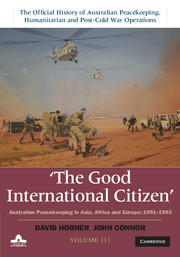Book contents
- Frontmatter
- Contents
- Maps
- Preface
- Chronology 1989–99
- Abbreviations
- Part 1 Strategy and policy
- Part 2 Cambodia
- Part 3 Western Sahara
- Part 4 Former Yugoslavia
- Part 5 Watch on Iraq
- 16 A new type of commitment
- 17 Disarming Iraq
- 18 A limited liability
- 19 Unscom and the US alliance
- Conclusion
- Appendix A United Nations Security Council resolutions
- Appendix B Major office bearers, 1991–99
- Bibliography
- Index
- Plate section
- References
16 - A new type of commitment
Humanitarian relief in Kurdistan, May–June 1991
from Part 5 - Watch on Iraq
Published online by Cambridge University Press: 12 May 2022
- Frontmatter
- Contents
- Maps
- Preface
- Chronology 1989–99
- Abbreviations
- Part 1 Strategy and policy
- Part 2 Cambodia
- Part 3 Western Sahara
- Part 4 Former Yugoslavia
- Part 5 Watch on Iraq
- 16 A new type of commitment
- 17 Disarming Iraq
- 18 A limited liability
- 19 Unscom and the US alliance
- Conclusion
- Appendix A United Nations Security Council resolutions
- Appendix B Major office bearers, 1991–99
- Bibliography
- Index
- Plate section
- References
Summary
Australia's commitment of seventy-five military personnel to a humanitarian relief mission in northern Iraq in May and June 1991 – known as Operation Habitat – was noteworthy for several reasons. It was the first Australian ground unit to be deployed to the Gulf and Iraq region since the First World War; but it would not be the last, as Australian units were to go to Kuwait in 1998 and to Iraq in 2003, with commitments extending for years beyond. Australia was also the only non-Nato country to deploy troops to northern Iraq in 1991, and this was yet another forerunner of future deployments; in 2006 Australian troops would become part of a Nato force in Afghanistan. Operation Habitat included the first Australian Army medical subunit to be deployed overseas since the Vietnam War. Again it would not be the last; medical units would go to Rwanda in 1994–95 and to East Timor and other countries in the years that followed. Further, this was the first time that Australian female soldiers deployed overseas with weapons.
Operation Habitat was the largest land-based Australian humanitarian mission to that time – a mission to alleviate human suffering by the provision of medical and engineering support, rather than to observe a ceasefire or to deter the recurrence of fighting. It was the beginning of similar humanitarian missions over succeeding years so, although the Habitat mission was relatively small and of only limited duration, it marked the beginning of a new pattern of Australian military commitments.
- Type
- Chapter
- Information
- The Good International CitizenAustralian Peacekeeping in Asia, Africa and Europe 1991–1993, pp. 395 - 426Publisher: Cambridge University PressPrint publication year: 2014

